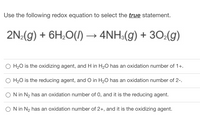
Chemistry
10th Edition
ISBN: 9781305957404
Author: Steven S. Zumdahl, Susan A. Zumdahl, Donald J. DeCoste
Publisher: Cengage Learning
expand_more
expand_more
format_list_bulleted
Concept explainers
Question
thumb_up100%
Use the following redox equation to select the true statement.
(picture attached)
A. H2O is the oxidizing agent, and H in H2O has an oxidation number of 1+.
B. H2O is the reducing agent, and O in H2O has an oxidation number of 2-.
C. N in N2 has an oxidation number of 0, and it is the reducing agent.
D. N in N2 has an oxidation number of 2+, and it is the oxidizing agent.

Transcribed Image Text:Use the following redox equation to select the true statement.
2N:(g) + 6H;0(1)→ 4NH:(g) + 302(g)
H20 is the oxidizing agent, and H in H20 has an oxidation number of 1+.
O H20 is the reducing agent, and O in H20 has an oxidation number of 2-.
N in N2 has an oxidation number of 0, and it is the reducing agent.
N in N2 has an oxidation number of 2+, and it is the oxidizing agent.
Expert Solution
This question has been solved!
Explore an expertly crafted, step-by-step solution for a thorough understanding of key concepts.
Step by stepSolved in 2 steps with 2 images

Knowledge Booster
Learn more about
Need a deep-dive on the concept behind this application? Look no further. Learn more about this topic, chemistry and related others by exploring similar questions and additional content below.Similar questions
- Select all the statements which are true about this reaction.Mg(s) + 2 HBr(aq) → MgBr2(aq) + H2(g) A. Magnesium is oxidized B. Magnesium is reduced C. Hydrogen is oxidized D. Hydrogen is reduced E. Bromine is oxidized F. Bromine is reducedarrow_forwardWhich method is used to make fake gold coins? Additive Plating: A plating reaction where metal cations are reduced by an electron donor in solution. The reduced cations coat the surface of an object. OR Displacement Plating A plating reaction is where metal cations are reduced by metals on the surface of an object. The reduced metal cations become neutral atoms and coat the object, replacing the oxidized metal atoms that become metal cations.arrow_forwardWhen MnO4– reacts to form Mn2+, the manganese in MnO4– is Group of answer choices a.reduced because its oxidation number decreases b.reduced because its oxidation number increases c.oxidized because its oxidation number decreases d.oxidized because its oxidation number increasesarrow_forward
- Balance each equation. Use the oxidation number method 3 c. Cr₂O, + Fe²+ → Cr³+ + Fe³+ (acidic conditions)arrow_forwardLecture 11 1. True or False? In general, atoms of metals lose electrons to form cations, and are therefore oxidized; while atoms of nonmetals gain electrons to form anions, and are therefore reduced. 2. Identify which reactant is undergoing oxidation and which is undergoing reduction. Mg + O₂ → MgO 3. Solid sodium reacts with aqueous copper (II) chloride produces aqueous sodium chloride and solid copper. Identify which reactant is undergoing oxidation and which is undergoing reduction. 4. What is the molecular mass of manganese(II) phosphate? 5. How many molecules of manganese (II) phosphate are there in 25.0 g of manganese(II) phosphate. 6. How many moles of carbon are there in 1.50 moles of butane, C4H10? 7. Calculate the molarity of 25.0 g of CoCl₂ dissolved in an aqueous solution with a total volume of 125.0 mL. 8. If 0.50 L of a 5.00-M solution of copper nitrate, Cu(NO3)2, is diluted to a volume of 1.75 L by the addition of water, what is the molarity of the diluted solution?arrow_forwardWhat is the oxidation level in the molecule below? Type in the number: 1, 2, 3, etc. CH₂CH3 CH3arrow_forward
arrow_back_ios
arrow_forward_ios
Recommended textbooks for you
 ChemistryChemistryISBN:9781305957404Author:Steven S. Zumdahl, Susan A. Zumdahl, Donald J. DeCostePublisher:Cengage Learning
ChemistryChemistryISBN:9781305957404Author:Steven S. Zumdahl, Susan A. Zumdahl, Donald J. DeCostePublisher:Cengage Learning ChemistryChemistryISBN:9781259911156Author:Raymond Chang Dr., Jason Overby ProfessorPublisher:McGraw-Hill Education
ChemistryChemistryISBN:9781259911156Author:Raymond Chang Dr., Jason Overby ProfessorPublisher:McGraw-Hill Education Principles of Instrumental AnalysisChemistryISBN:9781305577213Author:Douglas A. Skoog, F. James Holler, Stanley R. CrouchPublisher:Cengage Learning
Principles of Instrumental AnalysisChemistryISBN:9781305577213Author:Douglas A. Skoog, F. James Holler, Stanley R. CrouchPublisher:Cengage Learning Organic ChemistryChemistryISBN:9780078021558Author:Janice Gorzynski Smith Dr.Publisher:McGraw-Hill Education
Organic ChemistryChemistryISBN:9780078021558Author:Janice Gorzynski Smith Dr.Publisher:McGraw-Hill Education Chemistry: Principles and ReactionsChemistryISBN:9781305079373Author:William L. Masterton, Cecile N. HurleyPublisher:Cengage Learning
Chemistry: Principles and ReactionsChemistryISBN:9781305079373Author:William L. Masterton, Cecile N. HurleyPublisher:Cengage Learning Elementary Principles of Chemical Processes, Bind...ChemistryISBN:9781118431221Author:Richard M. Felder, Ronald W. Rousseau, Lisa G. BullardPublisher:WILEY
Elementary Principles of Chemical Processes, Bind...ChemistryISBN:9781118431221Author:Richard M. Felder, Ronald W. Rousseau, Lisa G. BullardPublisher:WILEY

Chemistry
Chemistry
ISBN:9781305957404
Author:Steven S. Zumdahl, Susan A. Zumdahl, Donald J. DeCoste
Publisher:Cengage Learning

Chemistry
Chemistry
ISBN:9781259911156
Author:Raymond Chang Dr., Jason Overby Professor
Publisher:McGraw-Hill Education

Principles of Instrumental Analysis
Chemistry
ISBN:9781305577213
Author:Douglas A. Skoog, F. James Holler, Stanley R. Crouch
Publisher:Cengage Learning

Organic Chemistry
Chemistry
ISBN:9780078021558
Author:Janice Gorzynski Smith Dr.
Publisher:McGraw-Hill Education

Chemistry: Principles and Reactions
Chemistry
ISBN:9781305079373
Author:William L. Masterton, Cecile N. Hurley
Publisher:Cengage Learning

Elementary Principles of Chemical Processes, Bind...
Chemistry
ISBN:9781118431221
Author:Richard M. Felder, Ronald W. Rousseau, Lisa G. Bullard
Publisher:WILEY